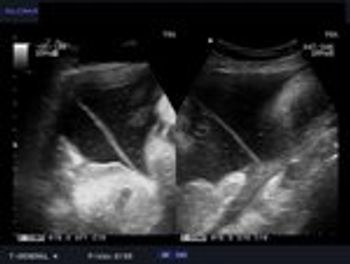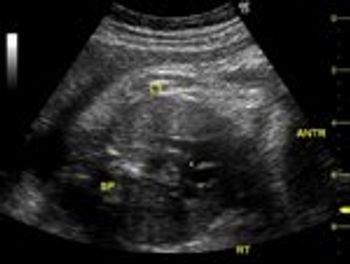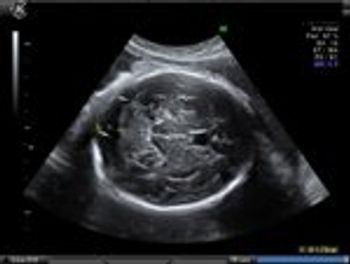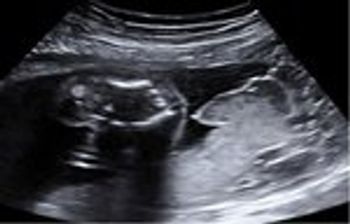
These are ultrasound images from a 2nd trimester pregnancy.

Which pharmacological and nonpharmacological options are safe and effective in reducing pain during labor?

According to new research, ST analysis for intrapartum monitoring can be a helpful tool that reduces operative deliveries and the need for additional fetal blood sampling. The results were published in a recent issue of Obstetrics & Gynecology.

A Danish study suggests that the intensity of a woman?s workout may influence how quickly she becomes pregnant.

Scientific evidence does not support annual Pap tests in most women, according to new cervical cancer screening guidelines issued by the United States Preventive Services Task Force.

Women who are overweight before pregnancy predispose their children to developing cardio-metabolic syndrome as young adults.

There is a good deal of emerging literature concerning the new automated multi-arrays utilizing peripheral blood samples for the identification of genetic abnormalities. Testing for 100 or more occult genetic disorders can now be rapidly processed by automated machinery with highly reproducible and reliable results.

OB/GYN physicians work hard every day. Making sure you get paid what you are due is a critical success factor for all physician practices. In 2012, industry experts estimate that 30% of total medical revenue will be collected from patients due to the increasing dollar thresholds for patient deductibles.

The North American Menopause Society has recently endorsed a flexible approach to the use of HRT that takes into account the individual patient’s needs, the type and timing of the therapy.

Premenstrual dysphoric disorder lasts longer than originally thought and is associated with at least four significant symptoms, according to a new research published in the Archives of General Psychiatry.

Although uterine leiomyomas are benign tumors, its symptoms, including anemia, excessive vaginal bleeding, pelvic pain, pressure-related bowel and bladder dysfunction, recurrent miscarriage and preterm labor, can severely negatively impact patients’ quality of life. Since uterine leiomyomas are three to four times more common in African-American patients, and since African-American women have 10 times higher incidence of hypovitaminosis D than white women, researchers sought to explore the impact of vitamin D3 on uterine leiomyomas.

Obese women, those who require operative vaginal delivery, and those who are younger than 25 are at high risk for childbirth-related sepsis.

Vitamin D?not calcium?can protect teen girls who engage in high-impact exercise from stress fractures.

Depression during pregnancy, whether treated with SSRIs or untreated, affects fetal head size.

This is a normal 3 vessel view of a 34 week old fetal heart.

Are the Benefits of Robotic Surgery Worth the Cost?

Our patient presented at 30 weeks gestation for a routine prenatal ultrasound.

Oral nifedipine and intravenous labetalol show similar efficacy in their ability to control hypertensive emergencies of pregnancy, according to new research published in BJOG: An International Journal of Obstetrics & Gynaecology.

Research suggests that prophylactic 17P can be useful in reducing the risk of spontaneous preterm delivery (SPTD), and one large study showed how compliance, and therefore results, can be improved.

Infants exposed to nicotine replacement therapy during pregnancy share an increased risk of colic similar to infants exposed to tobacco smoking.

Experts believe flavonoids protect against stroke by improving blood vessel function and reducing inflammation. Is vitamin C responsible for this effect?

In an effort to improve compliance with osteoporosis therapy, researchers tested telephone counseling as a motivator. Read more for the results.

Pressure is a better indicator of adequate pneumoperitoneum than volume or time before trocar entry in laparoscopic surgery, according to a recent study published in Journal of Minimally Invasive Gynecology.

How often do patients develop endometriosis following laparoscopic supracervical hysterectomy with uterine morcellation? To better understand the resulting rates of endometriosis via laparoscopic versus transvaginal or abdominal hysterectomies, researchers conducted a single center case-control study.

Here are two ultrasound images taken during the 3rd trimester of pregnancy.

With common and overlapping symptoms and subjective patient reporting, interstitial cystitis/painful bladder syndrome (IC/PBS) and bladder oversensitivity can be difficult to distinguish, making diagnosis and treatment recommendations tricky.

Poor communication is a leading cause of medical errors in this era of collaborative care. Effective communication strategies can help facilitate the continuity of care, prevent errors, and provide a safe environment for the patient.

What is your diagnosis of this 3rd trimester ultrasound?

Modern society has witnessed great improvements in everyday products, often thanks to advances in chemical compounds that make products better, stronger, and the like. Unfortunately, these advances may come at a cost, as prenatal exposure to some chemical compounds may have deleterious effects on offspring.

The perinatologist found a jaw abnormality on ultrasound but failed to diagnose the disorder. Read the facts, and see what you think.